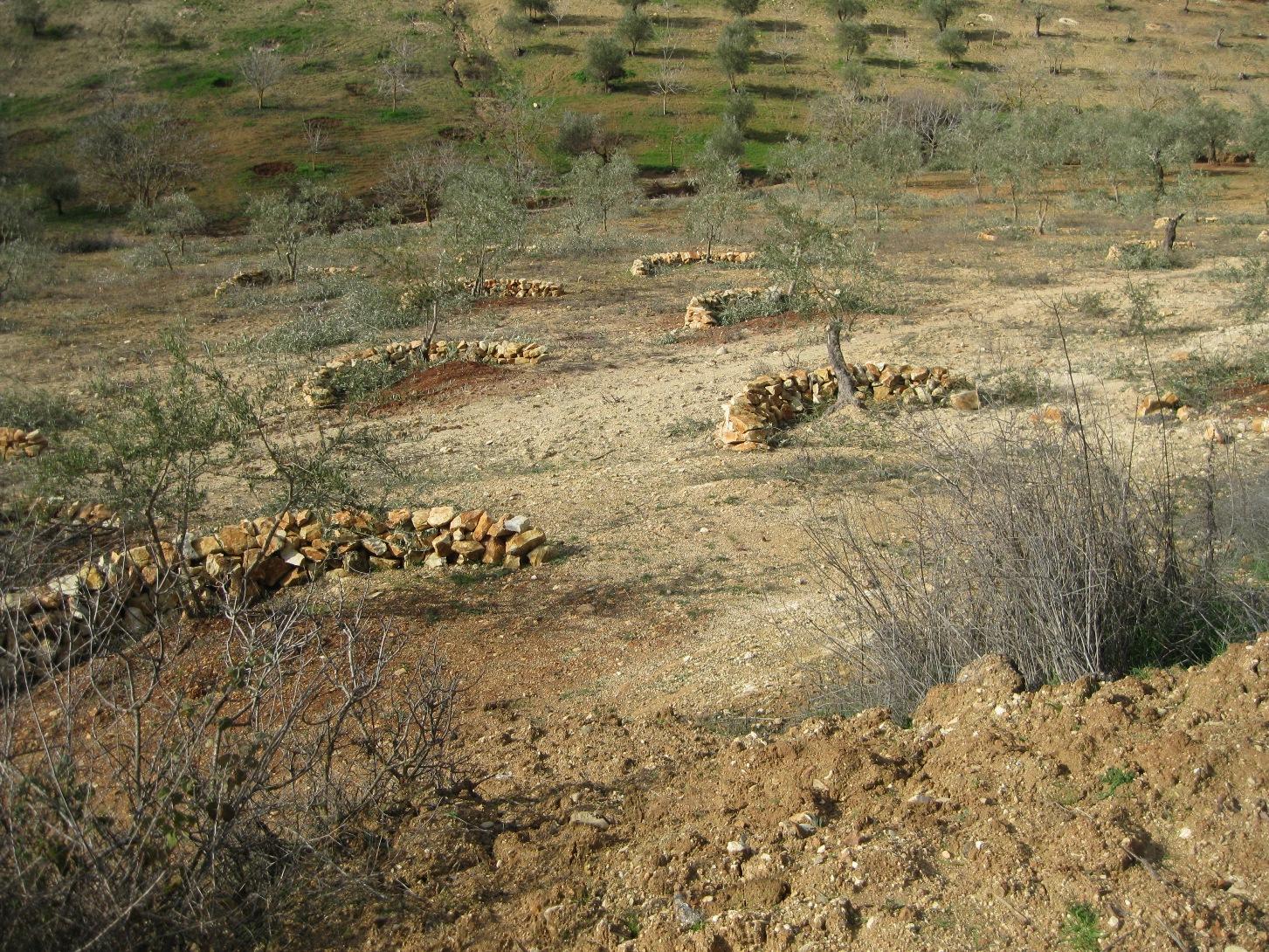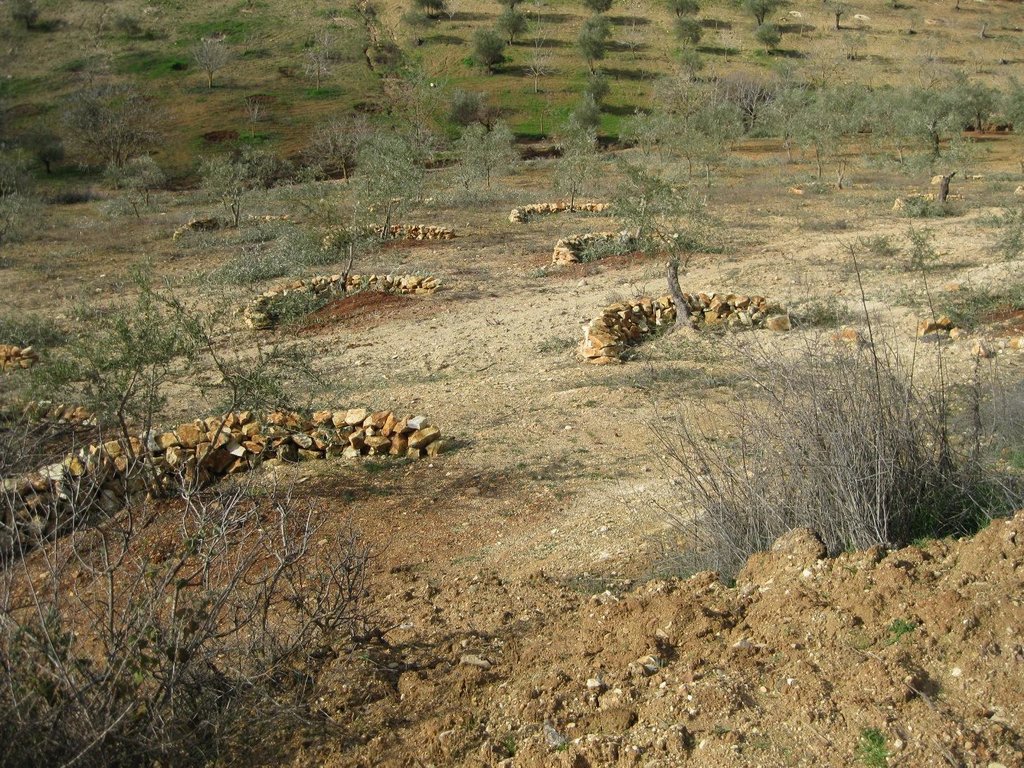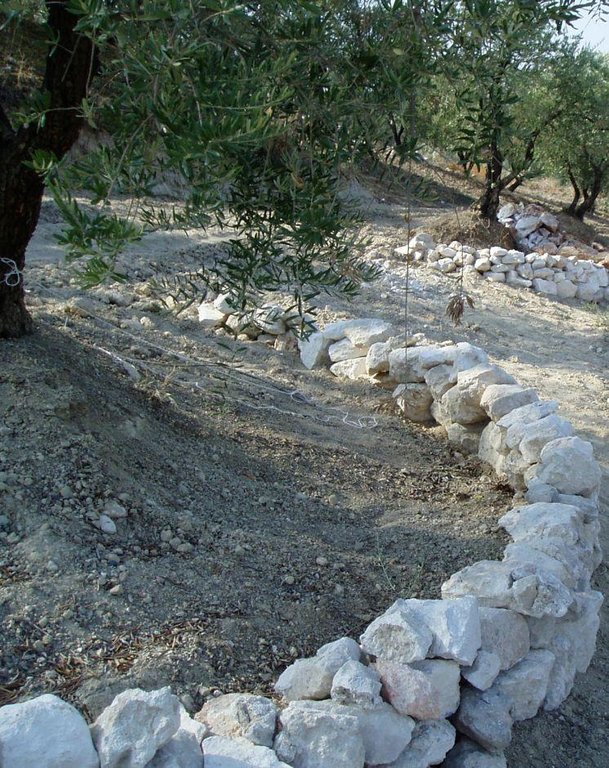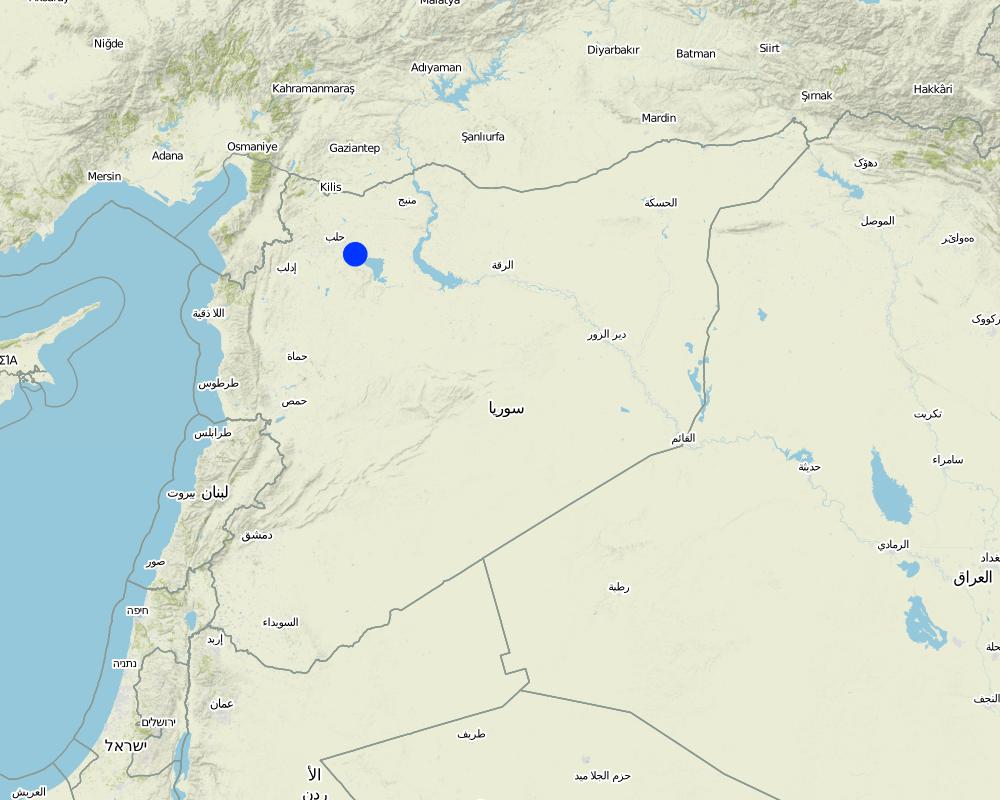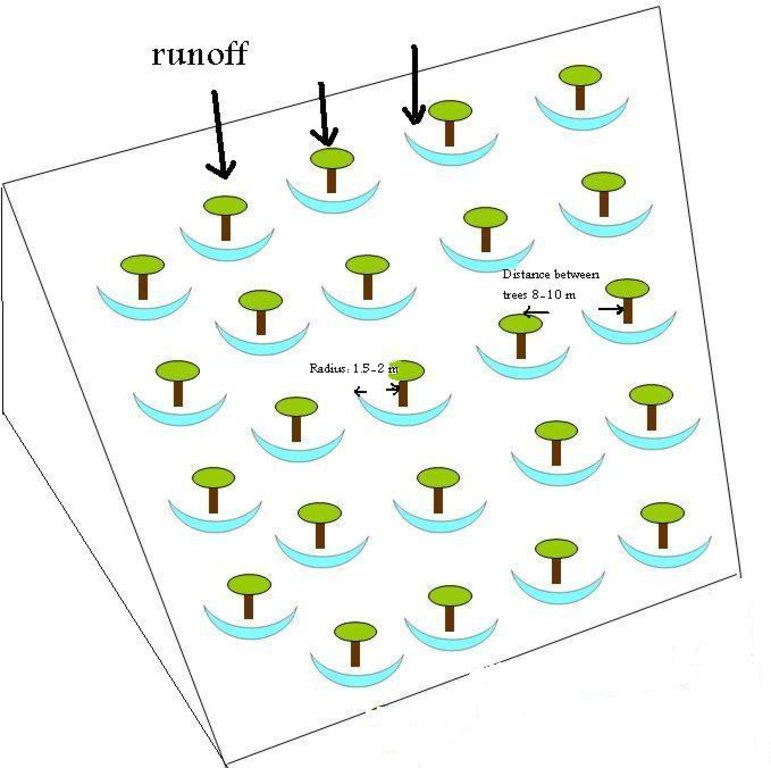Semi-circle bunds [阿拉伯叙利亚共和国]
- 创建:
- 更新:
- 编制者: kasem al ahmad
- 编辑者: –
- 审查者: Fabian Ottiger, Alexandra Gavilano
Aquas Hajariya, Aquas Hilalia (Half moon) Arabic
technologies_1549 - 阿拉伯叙利亚共和国
查看章节
全部展开 全部收起1. 一般信息
1.2 参与该技术评估和文件编制的资源人员和机构的联系方式
SLM专业人员:
SLM专业人员:
SLM专业人员:
Iizumi Yoshiko
Japan international research center for agricultural science
日本
有助于对技术进行记录/评估的机构名称(如相关)
International Center for Agricultural Research in the Dry Areas (ICARDA) - 黎巴嫩有助于对技术进行记录/评估的机构名称(如相关)
Japan international research center for agricultural science (JIRCAS) - 日本1.3 关于使用通过WOCAT记录的数据的条件
编制者和关键资源人员接受有关使用通过WOCAT记录数据的条件。:
是
2. SLM技术的说明
2.1 技术简介
技术定义:
Semi-circle stone bunds are used as soil conservation and water harvesting structures to reduce soil erosion and improve productivity of olive trees.
2.2 技术的详细说明
说明:
Semi-circle stone bunds are used as soil and water harvesting structures to improve productivity of trees, especially olive trees, on steep slopes. These are small-scale stone structures, with diameters between 3-5 m, established to catch rainfall and runoff from small micro-catchments covering relatively short slopes. This type of freestanding system (not contour system) is suitable for fields where trees are distributed in a staggered array. The slope steepness ranges from 15-40 degrees. Stones are mined from wasteland and transported to the slopes using tractors. Then the stones are set out in a semi circle (crescent) manually from a down side of the tree. The stone bunds are about 40 cm high with a base width of 30-40 cm. Most of the farmers add soil around the tree trunk and some of them add manure to improve the soil fertility. The technology makes the mechanized tillage difficult because of the layout of the structures. This reduces number of tillage operations and hence reduces erosion since tillage is one of the main causes of soil erosion under these conditions. The structures also reduce runoff velocity, which increases water availability for the plant roots (water harvesting) and also allows for more sedimentation around the trees and less transportation of soil particles and nutrients outside the field (soil conservation).
Purpose of the Technology: Semi-circle stone bunds are used to reduce losses of soil and nutrients and capture runoff water which helps to rehabilitate degraded land and improves the yield.
Establishment / maintenance activities and inputs: For one hectare of land with 100 bunds approximately 50 persons are needed to establish the bunds. The stones are set out in a semi-circle manually. A shovel is needed to prepare and level the stones bed. The costs are about $1950, which includes the price of the stones, transportation, equipment and labours. Then the bunds need maintenance every year, this will cost $54 per hectare. The perennial olive trees are mainly planted in January.
Natural / human environment: The area is dominated by steep slopes in a mountainous area in the north west of Syria. Small holdings are typical for this area with small plot sizes, narrow fields and shallow soil. Annual rainfall is between 400-600 mm. The technology was introduced to the community few years ago. Farmers were trained on how to layout, implement and maintain the structures by ICARDA and local extension services. Individual farmers are applying the technology on their own fields.
2.3 技术照片
2.5 已应用该技术的、本评估所涵盖的国家/地区/地点
国家:
阿拉伯叙利亚共和国
区域/州/省:
Aleppo, Idleb
有关地点的进一步说明:
Afrin (Maghara and Khaltan village) And Harem (Betya village)
具体说明该技术的分布:
- 均匀地分布在一个区域
如果不知道精确的区域,请注明大致覆盖的区域:
- < 0.1 平方千米(10 公顷)
注释:
Boundary points of the Technology area: Maghara(36.32.24.70),(36.39.21.84)
Khaltan(36.28.45),(36.42.30)
Bitya(36.07.57.38),(36.38.86.60)
Map
×2.6 实施日期
如果不知道确切的年份,请说明大概的日期:
- 不到10年前(最近)
2.7 技术介绍
详细说明该技术是如何引入的:
- 在实验/研究期间
3. SLM技术的分类
3.1 该技术的主要目的
- 改良生产
- 减少、预防、恢复土地退化
- 创造有益的经济影响
3.2 应用该技术的当前土地利用类型

农田
- 乔木与灌木的种植
乔木和灌木种植 - 指定作物:
- 橄榄树
每年的生长季节数:
- 1

牧场
粗放式放牧:
- 经营牧场
- Livestock density (if relevant): 50-100 LU /km2
注释:
Major land use problems (compiler’s opinion): soil erosion, low soil fertility and water shortage
Major land use problems (land users’ perception): decreasing productivity and high soil erosion
3.4 供水
该技术所应用土地的供水:
- 雨养
3.5 该技术所属的SLM组
- 横坡措施
- 集水
- 灌溉管理(包括供水、排水)
3.6 包含该技术的可持续土地管理措施

结构措施
- S2:堤、岸
3.7 该技术强调的主要土地退化类型

土壤水蚀
- Wt:表土流失/地表侵蚀
- Wo:场外劣化效应
注释:
Main type of degradation addressed: Wt: loss of topsoil / surface erosion, Wo: offsite degradation effects
Main causes of degradation: soil management (Tillage equipment (tractor instead of mule), direction (with slope), number of operations per year), deforestation / removal of natural vegetation (incl. forest fires), Heavy / extreme rainfall (intensity/amounts), poverty / wealth (need cash money for conservation measures)
Secondary causes of degradation: change of seasonal rainfall, population pressure, inputs and infrastructure: (roads, markets, distribution of water points, other, …) (difficult to access target fields, no roads), governance / institutional (poor extension services)
3.8 防止、减少或恢复土地退化
具体数量名该技术与土地退化有关的目标:
- 防止土地退化
- 减少土地退化
注释:
Main goals: mitigation / reduction of land degradation
Secondary goals: prevention of land degradation
4. 技术规范、实施活动、投入和成本
4.1 该技术的技术图纸
技术规范(与技术图纸相关):
Semi circle technology within olive tree field.
Date: 28/12/2011
Technical knowledge required for field staff / advisors: high
Technical knowledge required for land users: moderate
Main technical functions: reduction of slope length, increase / maintain water stored in soil, water harvesting / increase water supply, sediment retention / trapping, sediment harvesting
Secondary technical functions: control of dispersed runoff: retain / trap, control of dispersed runoff: impede / retard, reduction of slope angle, increase in organic matter, increase in nutrient availability (supply, recycling,…), increase of infiltration
Bund/ bank: semi-circular/V shaped trapezoidal
Height of bunds/banks/others (m): 0.3-0.5
Width of bunds/banks/others (m): 0.3-0.4
作者:
ICARDA, P.O.Box 5466, Aleppo, Syria
4.2 有关投入和成本计算的一般信息
其它/国家货币(具体说明):
Syrian pound (SYP)
如相关,注明美元与当地货币的汇率(例如1美元=79.9巴西雷亚尔):1美元=:
50.0
4.3 技术建立活动
| 活动 | 时间(季度) | |
|---|---|---|
| 1. | Stone mining | Dry season |
| 2. | Distributing stones and building | Dry season |
| 3. | Equipment | Dry season |
4.4 技术建立所需要的费用和投入
| 对投入进行具体说明 | 单位 | 数量 | 单位成本 | 每项投入的总成本 | 土地使用者承担的成本% | |
|---|---|---|---|---|---|---|
| 劳动力 | Distributing stones and building | ha | 1.0 | 753.0 | 753.0 | |
| 设备 | Machine use | ha | 1.0 | 184.0 | 184.0 | |
| 施工材料 | Stone | ha | 1.0 | 1029.0 | 1029.0 | |
| 技术建立所需总成本 | 1966.0 | |||||
| 技术建立总成本,美元 | 39.32 | |||||
注释:
Duration of establishment phase: 1 month(s)
4.5 维护/经常性活动
| 活动 | 时间/频率 | |
|---|---|---|
| 1. | Reforming the stone bunds | Dry season |
| 2. | Reforming the stone bunds | Dry season |
4.6 维护/经常性活动所需要的费用和投入(每年)
| 对投入进行具体说明 | 单位 | 数量 | 单位成本 | 每项投入的总成本 | 土地使用者承担的成本% | |
|---|---|---|---|---|---|---|
| 劳动力 | Reforming the stone bunds | ha | 1.0 | 54.0 | 54.0 | |
| 技术维护所需总成本 | 54.0 | |||||
| 技术维护总成本,美元 | 1.08 | |||||
注释:
Machinery/ tools: The farmers pay the whole amount. However, farmers are using a special micro-credit system, where the farmers take the money as a loan and pay it back in two consecutive seasons.
The costs was calculated based on stones availability in the area and the distance from the target field, also the accessibility to the field can increase the cost because it need more labors for transfer and to distribute the stones on the field.
Number of trees: 100/ha,
Radius=1.5m–2 m,
length=4.71m–6.28 m,
height=5 cm–35 cm,
width=40cm–50cm
4.7 影响成本的最重要因素
描述影响成本的最决定性因素:
stone availability
field accessibility
5. 自然和人文环境
5.1 气候
年降雨量
- < 250毫米
- 251-500毫米
- 501-750毫米
- 751-1,000毫米
- 1,001-1,500毫米
- 1,501-2,000毫米
- 2,001-3,000毫米
- 3,001-4,000毫米
- > 4,000毫米
有关降雨的规范/注释:
400-650 dry season May-October (6 months)
农业气候带
- 半湿润
- 半干旱
Thermal climate class: subtropics
Thermal climate class: temperate
5.2 地形
平均坡度:
- 水平(0-2%)
- 缓降(3-5%)
- 平缓(6-10%)
- 滚坡(11-15%)
- 崎岖(16-30%)
- 陡峭(31-60%)
- 非常陡峭(>60%)
地形:
- 高原/平原
- 山脊
- 山坡
- 山地斜坡
- 麓坡
- 谷底
垂直分布带:
- 0-100 m a.s.l.
- 101-500 m a.s.l.
- 501-1,000 m a.s.l.
- 1,001-1,500 m a.s.l.
- 1,501-2,000 m a.s.l.
- 2,001-2,500 m a.s.l.
- 2,501-3,000 m a.s.l.
- 3,001-4,000 m a.s.l.
- > 4,000 m a.s.l.
5.3 土壤
平均土层深度:
- 非常浅(0-20厘米)
- 浅(21-50厘米)
- 中等深度(51-80厘米)
- 深(81-120厘米)
- 非常深(> 120厘米)
土壤质地(表土):
- 中粒(壤土、粉土)
- 细粒/重质(粘土)
表土有机质:
- 低(<1%)
如有可能,附上完整的土壤描述或具体说明可用的信息,例如土壤类型、土壤酸碱度、阳离子交换能力、氮、盐度等。:
Soil fertility: Low
Soil drainage/infiltration: Medium (ranked 1) and poor (ranked 2)
Soil water storage capacity: High (ranked 1) and medium (ranked 2)
5.4 水资源可用性和质量
地表水的可用性:
好
关于水质和水量的注释和进一步规范:
Availability of surface water: Also medium (ranked 2)
5.6 应用该技术的土地使用者的特征
生产系统的市场定位:
- 生计(自给)
- 混合(生计/商业)
非农收入:
- 收入的10-50%
相对财富水平:
- 贫瘠
- 平均水平
个人或集体:
- 个人/家庭
机械化水平:
- 畜力牵引
- 机械化/电动
性别:
- 男人
说明土地使用者的其他有关特征:
Land users applying the Technology are mainly common / average land users
Annual population growth: negative
20% of the land users are average wealthy and own 40% of the land.
80% of the land users are poor and own 60% of the land.
Level of mechanization: Animal traction (mule tillage, ranked 1) and mechnaised (tractor tillage, ranked 2)
5.7 应用该技术的土地使用者使用的平均土地面积
- < 0.5 公顷
- 0.5-1 公顷
- 1-2 公顷
- 2-5公顷
- 5-15公顷
- 15-50公顷
- 50-100公顷
- 100-500公顷
- 500-1,000公顷
- 1,000-10,000公顷
- > 10,000公顷
这被认为是小规模、中规模还是大规模的(参照当地实际情况)?:
- 小规模的
5.8 土地所有权、土地使用权和水使用权
土地所有权:
- 个人,有命名
土地使用权:
- 个人
5.9 进入服务和基础设施的通道
健康:
- 贫瘠
- 适度的
- 好
教育:
- 贫瘠
- 适度的
- 好
技术援助:
- 贫瘠
- 适度的
- 好
就业(例如非农):
- 贫瘠
- 适度的
- 好
市场:
- 贫瘠
- 适度的
- 好
能源:
- 贫瘠
- 适度的
- 好
道路和交通:
- 贫瘠
- 适度的
- 好
饮用水和卫生设施:
- 贫瘠
- 适度的
- 好
金融服务:
- 贫瘠
- 适度的
- 好
6. 影响和结论性说明
6.1 该技术的现场影响
社会经济效应
生产
作物生产
水资源可用性和质量
灌溉用水需求
收入和成本
农业投入费用
注释/具体说明:
Tillage
农业收入
收入来源的多样性
工作量
注释/具体说明:
Harvesting
社会文化影响
食品安全/自给自足
SLM/土地退化知识
冲突缓解
社会经济弱势群体的情况
生态影响
水循环/径流
水的回收/收集
地表径流
土壤
土壤水分
土壤流失
养分循环/补给
土壤有机物/地下C
生物多样性:植被、动物
生物量/地上C
6.2 该技术的场外影响已经显现
旱季稳定可靠的水流
下游洪水
地下水/河流污染
对邻近农田的破坏
6.3 技术对渐变气候以及与气候相关的极端情况/灾害的暴露和敏感性(土地使用者认为的极端情况/灾害)
渐变气候
渐变气候
| 季节 | 增加或减少 | 该技术是如何应对的? | |
|---|---|---|---|
| 年温度 | 增加 | 好 |
气候有关的极端情况(灾害)
气象灾害
| 该技术是如何应对的? | |
|---|---|
| 局地暴雨 | 不好 |
| 局地风暴 | 好 |
气候灾害
| 该技术是如何应对的? | |
|---|---|
| 干旱 | 好 |
水文灾害
| 该技术是如何应对的? | |
|---|---|
| 比较和缓的(河道)洪水 | 不好 |
其他气候相关的后果
其他气候相关的后果
| 该技术是如何应对的? | |
|---|---|
| 缩短生长期 | 未知 |
6.4 成本效益分析
技术收益与技术建立成本相比如何(从土地使用者的角度看)?
短期回报:
轻度消极
长期回报:
稍微积极
技术收益与技术维护成本/经常性成本相比如何(从土地使用者的角度看)?
短期回报:
轻度消极
长期回报:
积极
6.5 技术采用
如若可行,进行量化(住户数量和/或覆盖面积):
52
注释:
50 land user families have adopted the Technology with external material support
Comments on acceptance with external material support: Farmers get loans through micro-credit system and not as payment
2 land user families have adopted the Technology without any external material support
There is a little trend towards spontaneous adoption of the Technology
6.7 该技术的优点/长处/机会
| 土地使用者眼中的长处/优势/机会 |
|---|
| Reducing soil erosion |
| Iincreasing soil moisture |
| Increasing yield |
| 编制者或其他关键资源人员认为的长处/优势/机会 |
|---|
|
Reducing soil erosion How can they be sustained / enhanced? Starting implementation at fields located at top of mountains and then down the slopes (need cooperation among farmers) |
|
Increasing soil depth and moisture around the tree How can they be sustained / enhanced? Provide enabling environment (such as micro credit system, proper extension and technical back stopping) |
6.8 技术的弱点/缺点/风险及其克服方法
| 土地使用者认为的弱点/缺点/风险 | 如何克服它们? |
|---|---|
| High cost (stone mining) | |
| High knowledge (extension service, training, guidance) | |
| Retard traditional tillage operation and harvesting |
| 编制者或其他关键资源人员认为的弱点/缺点/风险 | 如何克服它们? |
|---|---|
| High cost (stone mining) | consider the long-term benefit, it is feasible |
| Look for closer/ cheaper source of stones |
7. 参考和链接
7.1 信息的方法/来源
7.2 参考可用出版物
标题、作者、年份、ISBN:
Brochure, ICARDA, 2011
标题、作者、年份、ISBN:
Movie, ICARDA, 2011
7.3 链接到网络上的相关信息
标题/说明:
Poster
URL:
http://meetingorganizer.copernicus.org/EGU2010/poster_programme/2499 file number EGU2010-9237
链接和模块
全部展开 全部收起链接
无链接
模块
无模块


